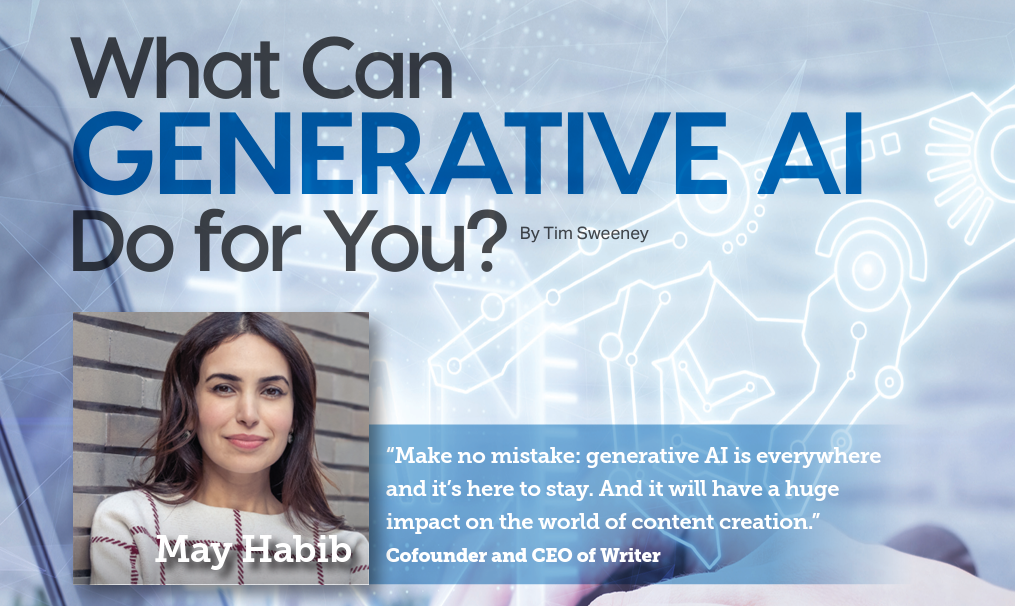Marketing disciplines are quickly adopting artificial intelligence in one form or another. Is it a threat, a benefit, or a complementary tool for writers, designers, and content creators?
Performing even a casual search on the benefits and risks associated with artificial intelligence will leave you scrolling for days. The arguments for it—increased productivity, reduction of human error, easy management of repetitive tasks, unbiased decisions—are often pitted against the arguments concerning the risk of privacy, the automation of human jobs, the ethics of its sourcing methods, and a decrease in creativity. British theoretical physicist Stephen Hawking once said that “the development of full artificial intelligence could spell the end of the human race.” That seems bad. But is it an overstatement? Time will tell. What we know for certain is that the use of artificial intelligence in the marketing field is well and truly here—and here to stay, according to experts.
”More than one research paper has concluded that AI might be the most disruptive technology since digital marketing.
I feel confident in saying that AI will transform all of our knowledge processes at work, not just content creation,” says May Habib, Cofounder and CEO of Writer, an artificial writing assistant for teams. “The disruption is happening now, and it’s up to all of us to make sure we get the best possible outcome.”
Habib isn’t exactly the only person who is bullish on the use of AI in marketing. Ann Handley, Chief Content Officer of MarketingProfs and international best-selling author and speaker, is excited that all this chatter about AI writing is quickly shifting the conversation away from the idea that “No one reads, and writing doesn’t matter anymore” to a new mantra: “Writing is the most important thing we do!”
“I love how everyone is all-in on words and writing,” Handley says. “Whether you believe AI is a game changer or not, there’s been a 180-degree turn towards the idea that words matter.”
For the uninformed, generative artificial intelligence (AI)—sometimes called augmented intelligence—is “the theory and development of computer systems that are able to perform tasks that normally require human intelligence, such as visual perception, speech recognition, decision-making, and translation between language” (as defined in Emerging Library Technologies by Ida Arlene Joiner). Within marketing, much of the publicity around AI pertains to its use in marketing software tools related to data, chatbots, customer journeys, and email marketing. Today, however, AI is being used in writing, content creation, and design. That’s why more than one research paper has concluded that AI might be the most disruptive technology since digital marketing.
“Generative AI uses machine learning to create or revise written content,” says Habib, an expert in natural language processing and the evolving ways we use language online. “It relies on a large language model (LLM), or an algorithm that understands data from a large data set and generates output or responds to questions based on its understanding of natural language-based inputs.”
While leaders across various industries are starting to see the extraordinary competitive advantage of implementing AI solutions, Habib says they are also seeing the extreme limitations and dangers that come from using generative models that are built for consumer use.
“Team leaders need more than the ability to generate creative stories and sonnets—they need to protect their brand and reputation,” she says.
Most commercial models, such as ChatGPT, draw intelligence (information) from public sources such as Wikipedia, social media posts, academic papers, and web pages. May Habib and Waseem Alshikh (Cofounder and CTO of Writer) created their platform to work differently. At the core of their technology is Palmyra, a proprietary family of LLMs trained on publicly available formal and business writing. More importantly, they are trained on a company’s own data, such as the style guide, brand voice, messaging, sample content, and company facts. The result is that customers get their own customized version of the model, and the data is used like an index. Most of Writer’s 100-plus customers—including Uber, L’Oréal, Deloitte, Spotify, HubSpot, and Hilton—are brand-conscious companies with more than 1,000 employees, often in technology, retail and e-commerce, financial services, and healthcare.
But what exactly is AI being used for in marketing on a day-to-day basis?
Writers—marketers, UX designers, editors, customer service professionals, and others—are using AI to save loads of time by generating drafts and new content from scratch. The real value, though, comes in the more tedious parts of the content development process: repurposing, analyzing, researching, transforming, and even distributing content. Habib uses the example of an original piece of written content, such as a blog post or a white paper. Generative AI can automatically take care of the time-consuming tasks that need to be done once the piece is finished: slicing it into smaller pieces such as summary bullets, making press abstracts, or creating email copy, social posts, or short copy for ads and SEO pieces.
“Another big area of value is being able to create or repurpose content to align to your editorial guidelines and ensure consistency of messaging, brand voice, key terminology, and company facts across all your people and use cases,” Habib explains. “That’s a huge downside of having all your people roll out their own AI rather than do it in an orchestrated manner.”
The AI process in a marketing scenario could work like this: A human uses words to apply an idea or creative concept to an algorithm. That algorithm then builds an asset that is judged by its model and produces an outcome. That result is based on what the machine (computer) has learned and anticipates. The upside is that this can all happen in a matter of seconds. The downside—depending on how you look at things—is that there is no back-and-forth with a human designer to arrive at an outcome closer to the one desired. Imagine, however, that you’re a client briefing a design team with your creative direction and then waiting days for them to reply with a first idea. Using AI, the early stages of the creative process could be reduced to a few minutes, and you could send the project down the desired creative path, rather than with a human designer’s misinterpretation. Even if the computer-generated design is way off track, you know where you don’t want to go, and a human can take over from there.
So, what does this type of artificial intelligence implementation mean for marketers? Should they view it as a threat to their livelihoods, or should they be using it to create better content, copy, and designs more efficiently and cost-effectively? The general consensus is that AI should be—and can be—a supplement to human creativity. Much like in the briefing scenario, Handley says writers—and those who rely on them—should think of AI as a robot perched on their shoulder.
“It’s not the creator at the keyboard, but a tool to help brainstorm, refine, edit, reimagine a blog post as a social post, or iterate on headlines,” Handley says. “Yes, writing is work, and that is fueling the frenzy around AI writing. A lot of us are looking for a way to shortcut the process, because we think AI is like a microwave that will heat our Hot Pocket in a jiffy, but it’s not like that because our content isn’t extruded and rolled and mass-produced, or it shouldn’t be, and because that’s not how we should use AI.”
May Habib is adamant that Writer was created to support content creators, not replace them—to take the tedious parts of writing off their plates, freeing them up to do the good stuff and enjoy the process as well. The platform works by snapping into a company’s business data sources to deliver accurate content wherever people write. It delivers a UI and sits in-line wherever you work, whether as a web app, Mac app, or plug-in to an application such as Figma or Contentful, and it suggests writing edits or improvements based on brand, messaging, and facts. It also serves as a place to create content. A user could tell it to “summarize that last paragraph” or “keep writing based on what I just wrote” or “improve the last three sentences.” Habib says that writing copy, however, is only about 10 percent of how the technology is used by clients. Use cases are as diverse as clinical customer communications, curricula and training material development, and market-moving information summarization.
“I’m thrilled that businesses are finding ways for generative AI to improve workflows and impact their bottom line. The power comes into play when you figure out how to have it help you streamline your process, not replace your process. It’s not meant to be your process. It’s something to bolt onto your process,” says Habib. “The transition from ‘this is cool’ to ‘this just helped me do my job better’ is happening right now, and it’s exciting to see. But by no means is it coming for peoples’ jobs.”
The fear or prediction that in the future, the byline of this article could read “Story by Tim, the AI Robot” is one thing, but there are bigger AI-related questions around security. Habib’s advice is to thoroughly read the terms and conditions of any AI tool you’re considering and confirm if it uses, keeps, and stores your data. If you’re considering implementing AI into your business, she recommends first gaining a complete understanding of the tool you choose. Besides determining its data security level, find out if it allows you to customize output based on your brand, style, messages, and company facts and if it can it be integrated into your business, writing, or creative workflow.
Whether or not you are a writer, a certain amount of trepidation is normal when disruptive new tools like the ones presented by the recent AI boom come along. In fact, many have compared AI to the adoption of the internet. Habib offers another analogy. “I think it’s more like electricity, which took time to fully adapt and use its capabilities to the full extent,” she says. “With AI, it’s going to take time to learn best practices and teach them to others. AI is really about us upscaling as humans and the processes of how we approach work.”
When it comes to communication, Handley believes AI tools are best used to prompt new thinking and get new ideas out of your head. From there, it’s about layering in your unique point of view and ability to tell a story to another person. That skill, she believes, will never be replaced by a robot.
“The advent of AI makes one thing really clear to me: your relationship with your audience matters more than ever,” Handley says. “The AI tool has to go through you and be wrapped with your voice and your narrative, and your ability to build a relationship with readers through your words is the differentiator. You may write faster first drafts, but you can’t shortcut relationships. You can’t prompt your way to trust.”
See how SmartQ™ can work for you.
Download the free whitepaper.







